Talli is a traditional embellishment technique found in the Arabian Gulf countries, particularly the United Arab Emirates (UAE). The word Talli has two meanings.
- Originating from the Turkish word tel meaning ‘shining thread’ or ‘wire’, it refers to the flat metal straw or ribbon known as khus in Khaleeji Arabic, the dialect used in the Gulf countries including the UAE.
- The word talli refers to the craft of weaving a braid and applying it to fabric using a couching stitch. This unique style of embroidery uses the metallic straw (khus) twisted, twined, or braided with silk (brisam), cotton (gutun) or synthetic (nāīlon) threads to create cords, braids, bands, or ribbons (fatlat or ftul) of varying patterns.
This same form of embellishment is also known as mnaqad/mnaghad and can be found in countries as far away as China and India where it is known as badlah meaning silverwork.
In this post, we will look at the second meaning – Talli as a craft and embellishment used to decorate garments.
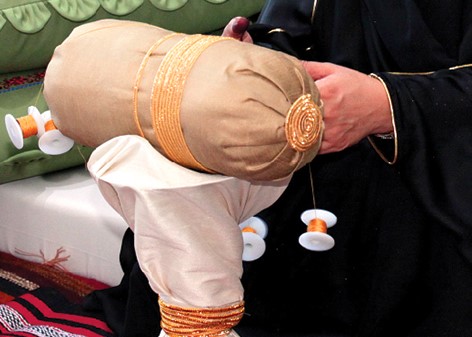
A cone-shaped metal (kajooja) with a cylindrical pillow (al-arah) positioned on top creating a mount. The spools of threads in use are pinned to the pillow. Image credit: Al Ghadeer UAE Crafts
Function and Tools
Talli is created by weaving strands of thread together into intricate patterns creating a braid to embellish garments, traditionally applied to the collars and sleeves of a woman’s overgarment (abayah or thawb) as well as on the leg cuffs of the women’s underpants (sirwal). The braid is woven using a cone-shaped metal (kajujah) with a cylindrical pillow (al-arah) positioned on top creating a mount. The spools of threads in use are pinned to the pillow.
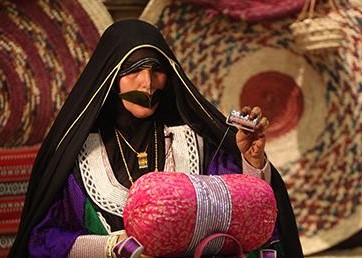
Ateeja Ali Al Muhairbi produces telli work at the Abu Dhabi General Women’s Union. Image Credit: The National Newspaper, Dec 1, 2011.
Method
Talli is woven using several lines of silk, cotton, or nylon threads in various colours, combined with gold or silver metallic to create intricate and unique braids. Traditionally, the metallic straw would be real silver or gold, but synthetic materials have replaced the much more expensive alternative. The braiding process can take anywhere from a couple of hours to weeks depending on the pattern. The hand-woven braid is manipulated and created based on the artist’s eye and creativity, meaning each braid is a unique piece. Many Talli patterns are inspired by the natural environment and replicated based on the eye of the beholder into various designs and levels of intricacy.
Tradition
The craft of Talli making was traditionally passed from mother to daughter and has its history rooted in Bedouin tribes. Historically, women would learn the art of talli to make and design their clothes. They learn and practice the craft joined by their female relatives and neighbours. Some women would immerse themselves in the craft during the pearl-diving season when the family men would leave to dive.
Future and Legacy
Although it has survived through the age of mass production where braids machine-made in Korea and Japan flooded the market, talli making was for a while considered a dying craft as fewer and fewer young Arab women learned the craft. The embellishment that was once found everywhere in their daily dress and lifestyle became less fashionable as modern Arab women leaned towards the more Western and corporate dress. But slowly the craft is making a comeback in small niche sectors around the country. Craft initiatives such as Irthi Contemporary Crafts Council and Al Ghadeer UAE Crafts have actively been attempting to revive the craft and Emirati fashion designers have also been employing the handmade embroidery technique in their designs showcasing it around the globe. Handmade talli embroidery can now be found adorning modern pieces like handbags, collars, sleeves, belts, tableware, jewellery, etc.
Design Glossary
We have identified more than 40 different styles of talli designs to date. The six mentioned here are some of the more popular designs found in our collection:
- Talli ain mozah: meaning Mozah’s eye. In Arabic, mozah means banana but in the Gulf dialect it refers to a precious oblong pearl, which is how this tallī motif gets its name; it features a repeating oblong shape that resembles an eye.
- Talli bu al mishakhis w lozah: referencing gold ornaments (mishākhis) meaning wide-eyed and the shape of an almond seed (lozah). The design is created in a repetitive line using both motifs.
- Talli_fatlah: The term fatlah means one strand. The design resembles a running stitch. The effect is achieved by continuously looping metallic threads with other silk, cotton, or synthetic ones. Also known as tallī khūsah.
- Talli finkh al batikhah: Referring to the shape of a slice of melon (finkh or batikhah). The design is created in repetitive diagonal, half-chevron lines.
- Talli grin al agl: The Arabic term qarn al’aqil means ‘calf’s horn’. It is a variant double line of the tellīghūlī
- Talli minsharah: The Arabic term minshar means ‘a saw’ and refers to the sharp-edged saw-tooth pattern created.
Tur bi talli
This roughly translates from Arabic as ‘net with metal’. A net-like textile such as cotton or linen mesh, embellished with small strips of silver or metal tallī or khūs. Using a flat needle, the silver or alloy straws are woven through the net, then pressed and flattened with the fingers forming small specks placed on the fabric to create vegetative or geometric motifs. Also known as Assuiti as it originates from the town of Assuit in Egypt. It is known by different names in different parts of the world, sometimes referred to as mnaghad/mnaqad or naghdah/naqdah. In the Gulf region, it is sometimes referred to simply as talli.
*This post was researched and written by our intern Rifal Imam.
**To learn more about our intern program or register your interest contact our content manager at sm@thezay.org.
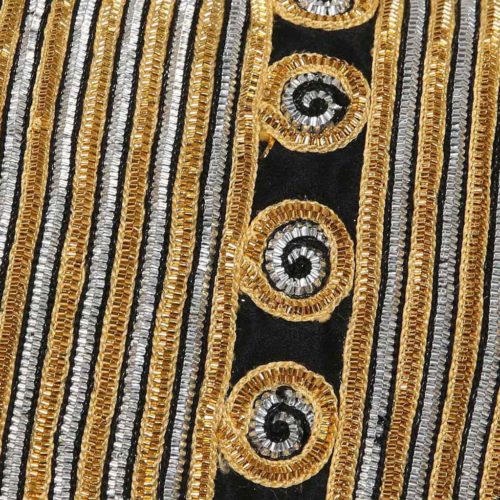
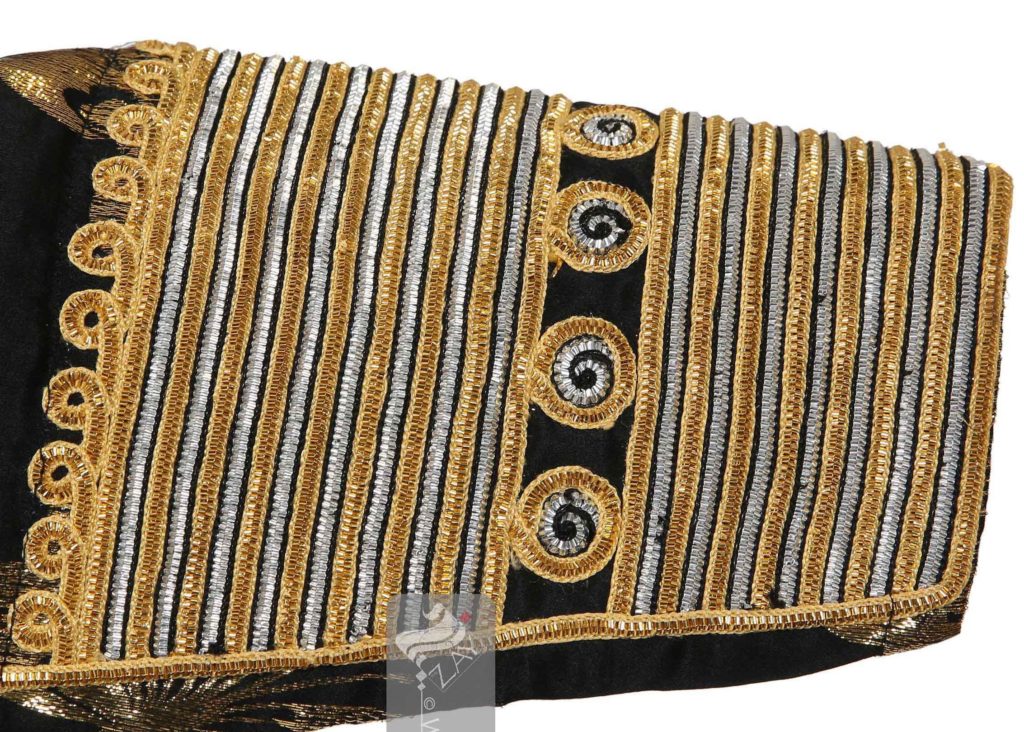
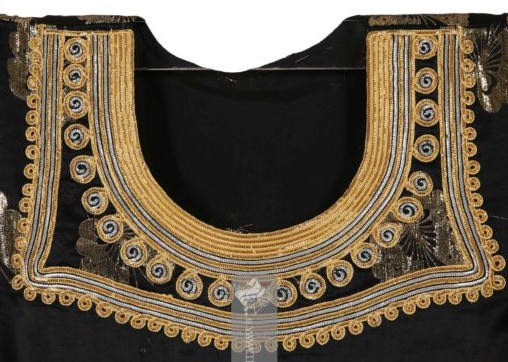


Latest Comments
POST YOUR OPINIONTulle bi Telli - The Zay Initiative
April 7, 2021[…] ribbon used to embellish tulle. More information about the second definition can be found in this @@@@Telli Embroidery post, and in this post on […]
Metal Thread Embroidery in the Arab World – History and Context - The Zay Initiative
May 27, 2022[…] Applied embroidery, where the metal thread is used to create a notion or embellishment that is applied to a garment as decoration. […]